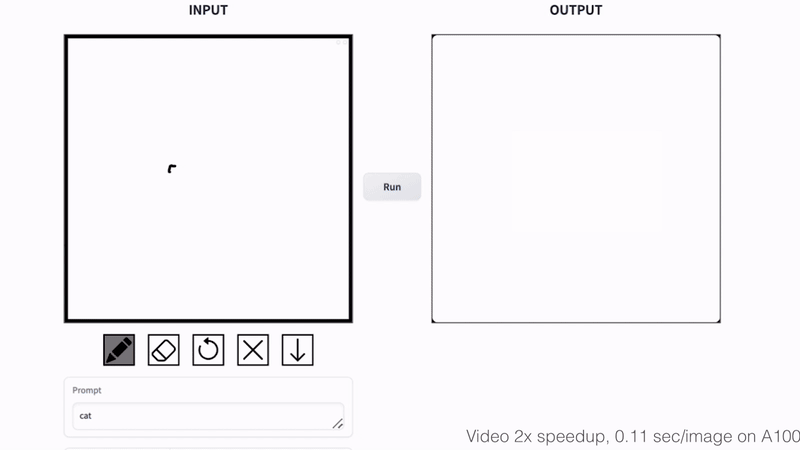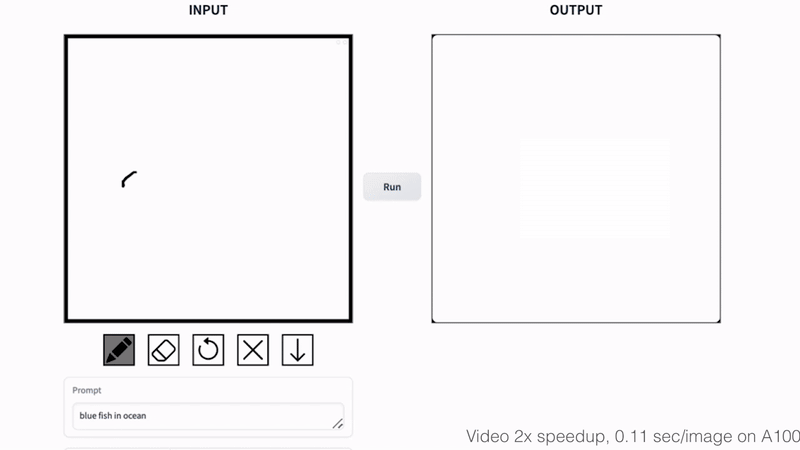Quick start: Running Locally | Gradio (locally hosted) | Training
We propose a general method for adapting a single-step diffusion model, such as SD-Turbo, to new tasks and domains through adversarial learning. This enables us to leverage the internal knowledge of pre-trained diffusion models while achieving efficient inference (e.g., for 512x512 images, 0.29 seconds on A6000 and 0.11 seconds on A100).
Our one-step conditional models CycleGAN-Turbo and pix2pix-turbo can perform various image-to-image translation tasks for both unpaired and paired settings. CycleGAN-Turbo outperforms existing GAN-based and diffusion-based methods, while pix2pix-turbo is on par with recent works such as ControlNet for Sketch2Photo and Edge2Image, but with one-step inference.
One-Step Image Translation with Text-to-Image Models
Gaurav Parmar, Taesung Park, Srinivasa Narasimhan, Jun-Yan Zhu
CMU and Adobe, arXiv 2403.12036
Edge to Image
By varying the input noise map, our method can generate diverse outputs from the same input conditioning. The output style can be controlled by changing the text prompt.
Day to Night
Night to Day
Clear to Rainy
Rainy to Clear
Our Generator Architecture: We tightly integrate three separate modules in the original latent diffusion models into a single end-to-end network with small trainable weights. This architecture allows us to translate the input image x to the output y, while retaining the input scene structure. We use LoRA adapters in each module, introduce skip connections and Zero-Convs between input and output, and retrain the first layer of the U-Net. Blue boxes indicate trainable layers. Semi-transparent layers are frozen. The same generator can be used for various GAN objectives.
Environment Setup
- We provide a conda env file that contains all the required dependencies.
conda env create -f environment.yaml - Following this, you can activate the conda environment with the command below.
conda activate img2img-turbo - Or use virtual environment:
python3 -m venv venv source venv/bin/activate pip install -r requirements.txt
Paired Image Translation (pix2pix-turbo)
-
The following command takes an image file and a prompt as inputs, extracts the canny edges, and saves the results in the directory specified.
python src/inference_paired.py --model_name "edge_to_image" \ --input_image "assets/examples/bird.png" \ --prompt "a blue bird" \ --output_dir "outputs"
Input Image Canny Edges Model Output 


-
The following command takes a sketch and a prompt as inputs, and saves the results in the directory specified.
python src/inference_paired.py --model_name "sketch_to_image_stochastic" \ --input_image "assets/examples/sketch_input.png" --gamma 0.4 \ --prompt "ethereal fantasy concept art of an asteroid. magnificent, celestial, ethereal, painterly, epic, majestic, magical, fantasy art, cover art, dreamy" \ --output_dir "outputs"
Input Model Output 

Unpaired Image Translation (CycleGAN-Turbo)
-
The following command takes a day image file as input, and saves the output night in the directory specified.
python src/inference_unpaired.py --model_name "day_to_night" \ --input_image "assets/examples/day2night_input.png" --output_dir "outputs"Input (day) Model Output (night) 

-
The following command takes a night image file as input, and saves the output day in the directory specified.
python src/inference_unpaired.py --model_name "night_to_day" \ --input_image "assets/examples/night2day_input.png" --output_dir "outputs"Input (night) Model Output (day) 

-
The following command takes a clear image file as input, and saves the output rainy in the directory specified.
python src/inference_unpaired.py --model_name "clear_to_rainy" \ --input_image "assets/examples/clear2rainy_input.png" --output_dir "outputs"Input (clear) Model Output (rainy) 

-
The following command takes a rainy image file as input, and saves the output clear in the directory specified.
python src/inference_unpaired.py --model_name "rainy_to_clear" \ --input_image "assets/examples/rainy2clear_input.png" --output_dir "outputs"Input (rainy) Model Output (clear) 

- We provide a Gradio demo for the paired image translation tasks.
- The following command will launch the sketch to image locally using gradio.
gradio gradio_sketch2image.py - The following command will launch the canny edge to image gradio demo locally.
gradio gradio_canny2image.py
- See the steps here for training a pix2pix-turbo model on your paired data.
- See the steps here for training a CycleGAN-Turbo model on your unpaired data.
Our work uses the Stable Diffusion-Turbo as the base model with the following LICENSE.









